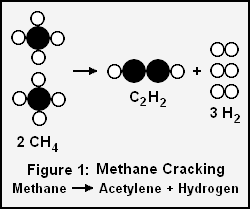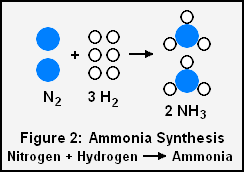User:Milton Beychok/Sandbox: Difference between revisions
imported>Milton Beychok m (→Calculations) |
imported>Milton Beychok |
||
| Line 6: | Line 6: | ||
==Calculations== | ==Calculations== | ||
{{Image|Methane Cracking.png|right|250px}} | {{Image|Methane Cracking.png|right|250px}} | ||
{{Image|Ammonia Synthesis.png|right|2200px | {{Image|Ammonia Synthesis.png|right|2200px}} | ||
Gas stoichiometry calculations solve for the unknown [[volume]] or [[mass]] of a gaseous product or reactant. For example, if we wanted to calculate the volume of gaseous NO<sub>2</sub> produced from the combustion of 100 g of NH<sub>3</sub>, by the reaction: | Gas stoichiometry calculations solve for the unknown [[volume]] or [[mass]] of a gaseous product or reactant. For example, if we wanted to calculate the volume of gaseous NO<sub>2</sub> produced from the combustion of 100 g of NH<sub>3</sub>, by the reaction: | ||
Revision as of 18:54, 19 June 2010
Gas stoichiometry is the quantitative relationship (ratio) between reactants and products in a chemical reaction with reactions that produce gases. Gas stoichiometry applies when the gases produced are assumed to be ideal, and the temperature, pressure, and volume of the gases are all known. The ideal gas law is used for these calculations. Often, but not always, the standard temperature and pressure (STP) are taken as 0°C and 1 bar and used as the conditions for gas stoichiometric calculations.
Etymology
"Stoichiometry" is derived from the Greek words στοιχεῖον (stoicheion, meaning element]) and μέτρον (metron, meaning measure.)
Calculations
Gas stoichiometry calculations solve for the unknown volume or mass of a gaseous product or reactant. For example, if we wanted to calculate the volume of gaseous NO2 produced from the combustion of 100 g of NH3, by the reaction:
- 4NH3 (g) + 7O2 (g) → 4NO2 (g) + 6H2O (l)
we would carry out the following calculations:
There is a 1:1 molar ratio of NH3 to NO2 in the above balanced combustion reaction, so 5.871 mol of NO2 will be formed. We will employ the ideal gas law to solve for the volume at 0 °C (273.15 K) and 1 atmosphere using the gas law constant of R = 0.08206 L · atm · K−1 · mol−1 :
Gas stoichiometry often involves having to know the molar mass of a gas, given the density of that gas. The ideal gas law can be re-arranged to obtain a relation between the density and the molar mass of an ideal gas:
- and
and thus:
| where: | |
| = absolute gas pressure | |
| = gas volume | |
| = number of moles | |
| = universal ideal gas law constant | |
| = absolute gas temperature | |
| = gas density at and | |
| = mass of gas | |
| = molar mass of gas |
















